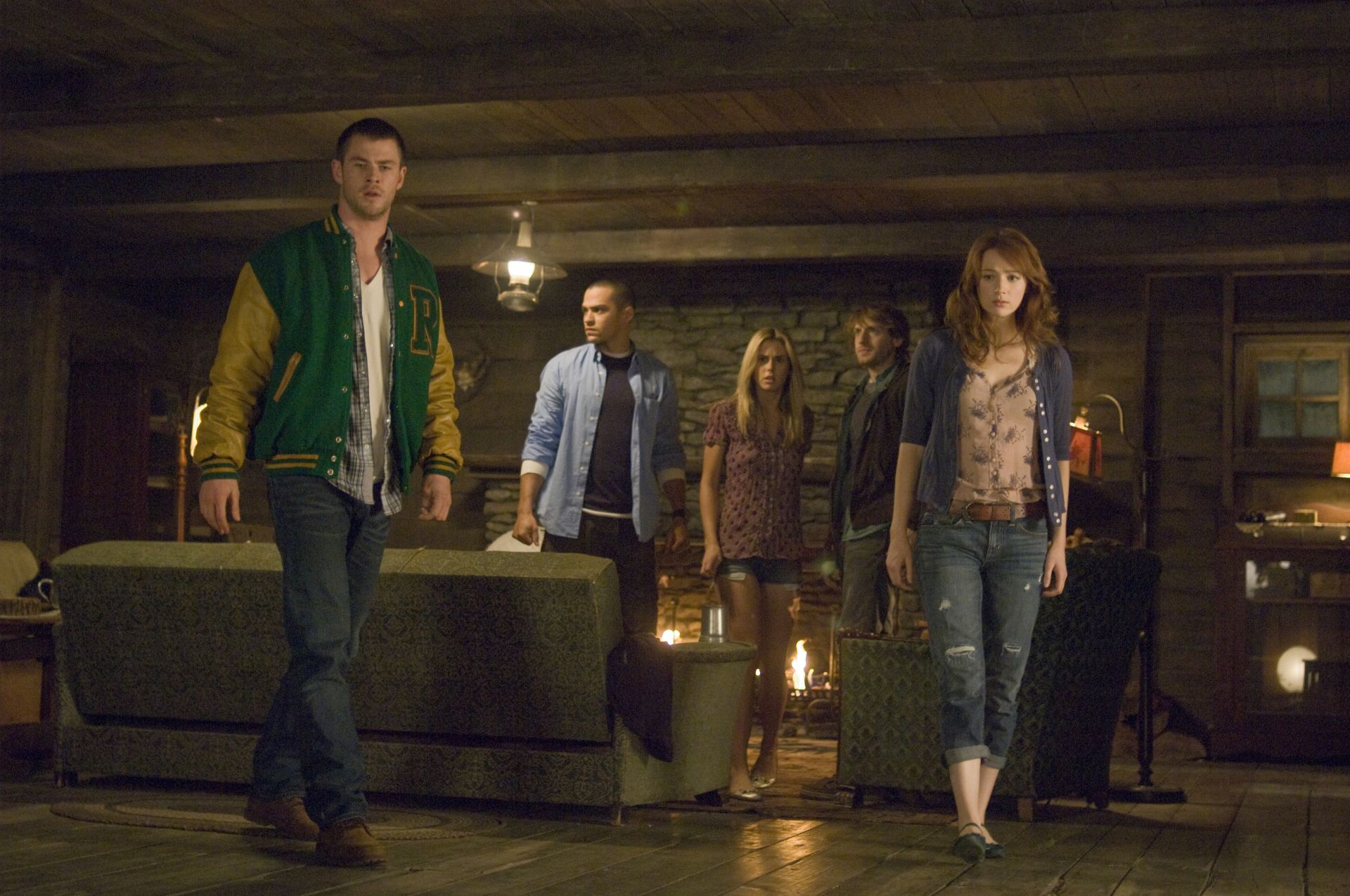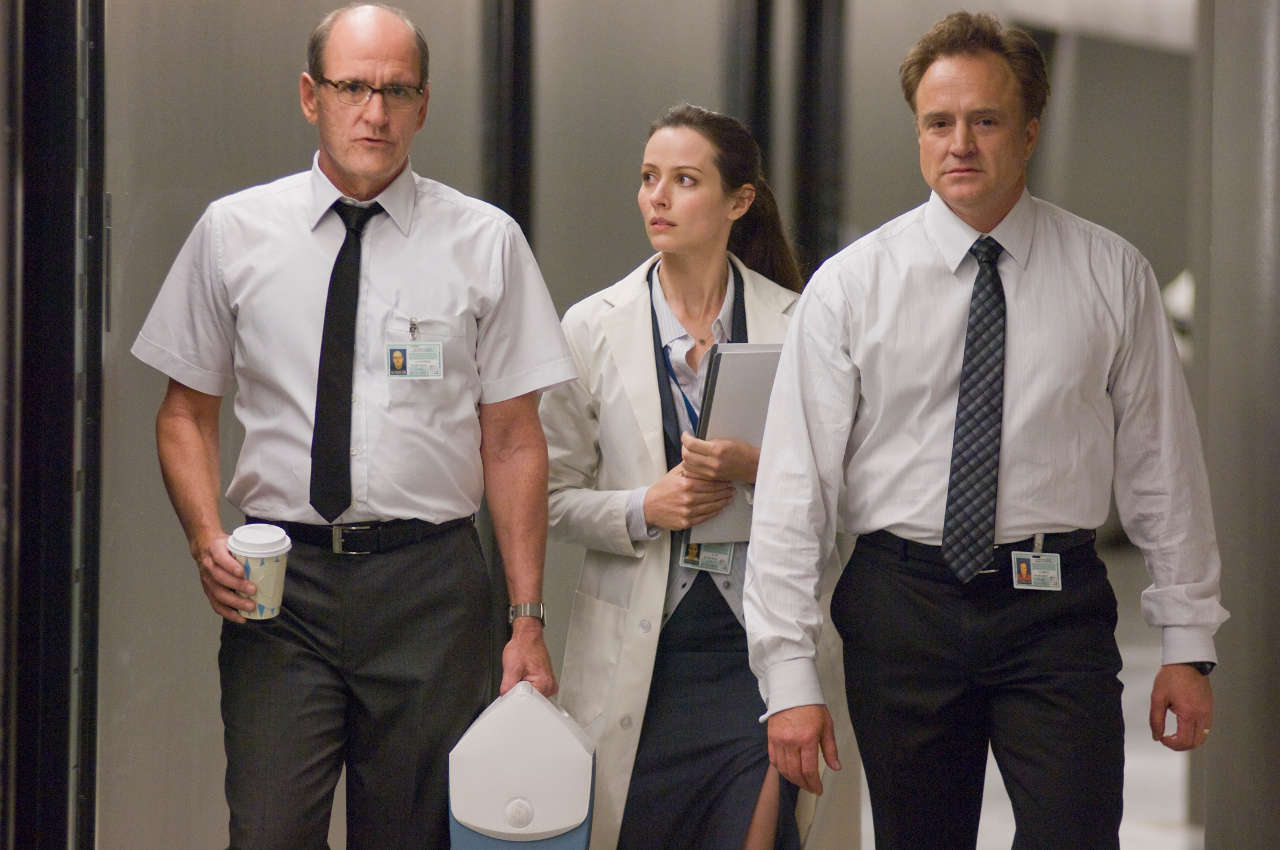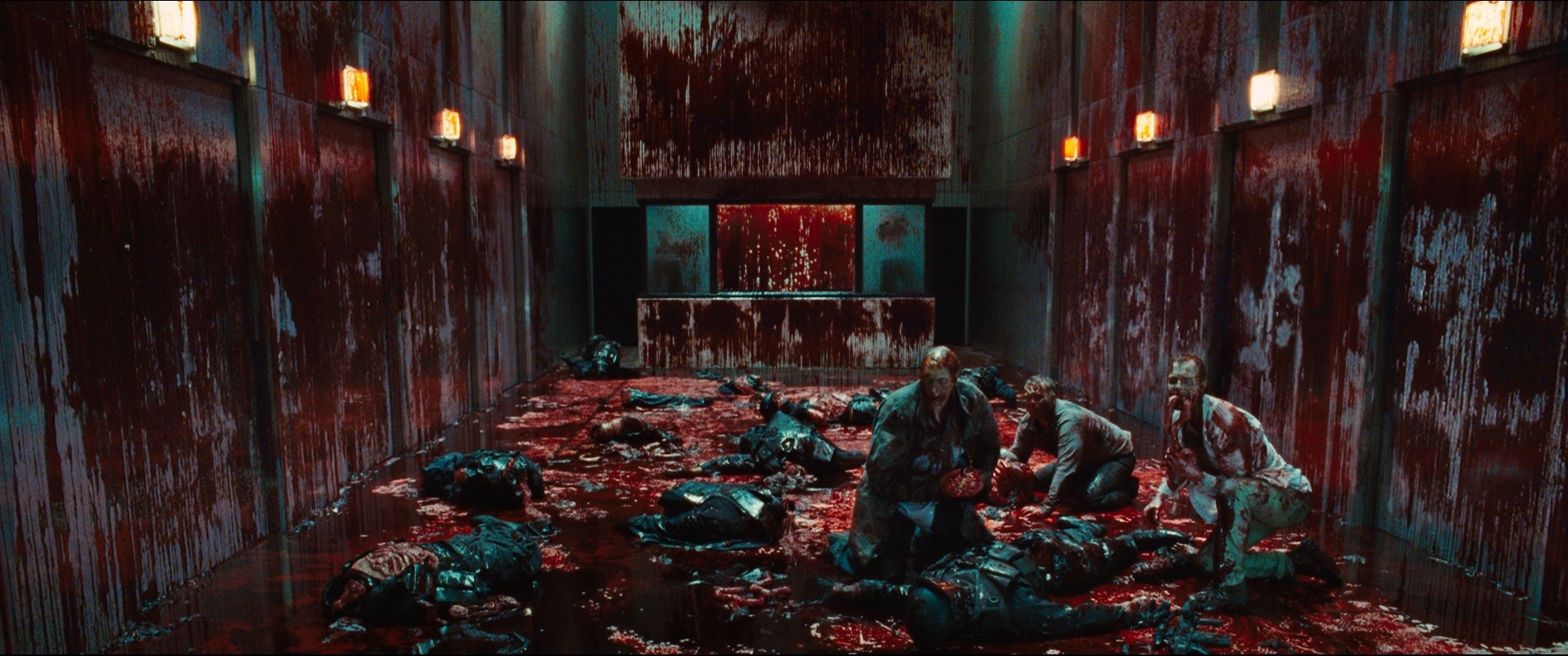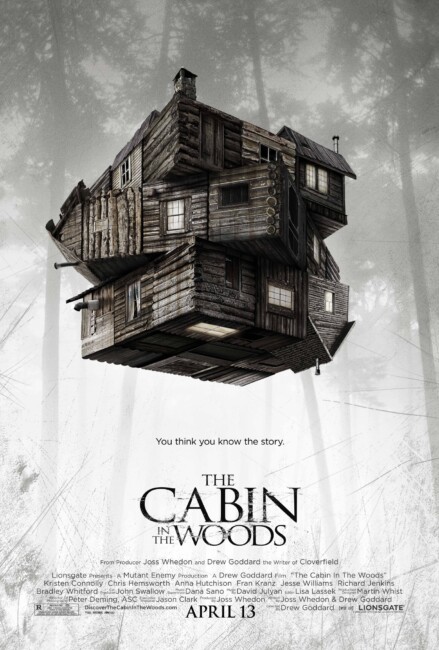USA. 2012.
Crew
Director – Drew Goddard, Screenplay – Drew Goddard & Joss Whedon, Producer – Joss Whedon, Photography – Peter Deming, Music – David Julyan, Visual Effects Supervisor – Todd Shifflett, Visual Effects – Rhythm & Hues Studio (Supervisor – Richard Malzahn), Special Effects Supervisor – Joel Whist, Makeup Effects – AFX Studio (Supervisor – David Leroy Anderson), Production Design – Martin Whist. Production Company – Mutant Enemy.
Cast
Kristen Connolly (Dana), Fran Kranz (Marty), Chris Hemsworth (Curt), Anna Hutchison (Jules), Jesse Williams (Holden), Richard Jenkins (Sitterson), Bradley Whitford (Hadley), Amy Acker (Lin), Tim De Zarn (Mordecai), Brian White (Truman), Sigourney Weaver (The Director)
Plot
Five college friends go up to a cabin in the woods, the Buckner House, for the weekend. As they settle in and begin partying, their every move is monitored by a group of technicians who have the cabin wired with hidden cameras and are tweaking what the group do with the use of behaviour-changing chemicals. Their every move is subtly guided and bets made on the outcome of their choices by the technicians. In the cellar, they discover a bunch of junk, including a journal written by the Buckners from the turn of the century. When Dana reads out the Latin inscription written in the journal, this causes the zombified Buckners to rise from the ground in the woods outside and head towards the cabin to kill them. As the group try to defend themselves, it appears that the technicians are allowing this to happen according to an elaborate plan where the group are to be ritually sacrificed to prevent something ancient and terrible from awakening. However, as the group fight back, things do not quite go according to their controllers’ plan.
The Cabin in the Woods is a horror film written and produced by Joss Whedon, who has become a cult figure for his work in television as creator of series like Buffy the Vampire Slayer (1997-2003), Angel (1999-2004), Firefly (2002-3) and Dollhouse (2008-10), as well as director of the Firefly film spinoff Serenity (2005) and the smash successes of The Avengers (2012) and Avengers: Age of Ultron (2015). Whedon has also produced the fandom documentary Comic-Con Episode IV: A Fan’s Hope (2011), produced/wrote the psychic link film In Your Eyes (2014), wrote and performed uncredited directing duties on Justice League (2017) and earlier than that had written the screenplays for a variety of genre films including Buffy the Vampire Slayer (1992), Toy Story (1995), Alien: Resurrection (1997), Titan A.E. (2000) and Atlantis: The Lost Empire (2001).
The Cabin in the Woods is directed and co-written by Drew Goddard. As the poster for The Cabin in the Woods proudly announces, it is from the writer of Cloverfield (2008). Drew Goddard started out as a scriptwriter on Whedon’s Buffy the Vampire Slayer and Angel, becoming a story editor on the latter, before jumping ship to the J.J. Abrams camp to write and produce numerous episodes of Alias (2001-6) and Lost (2004-10).
The oddity about The Cabin in the Woods is the bizarreness of its marketing campaign. Despite having its eventual US release date changed to only three weeks before the massive hit of Joss Whedon’s The Avengers, also starring Chris Hemsworth, the film failed to make any mention of this in its publicity campaign. More prominent in the advertising was the legend of “from the writer of Cloverfield” where you get the impression that the marketing department was run by teenagers who had no awareness of anything that had not been made in the last five years.

This seemed endemic of the misguided problems going on with the film. The film was originally shot in 2009 but was held up first by the bankruptcy of MGM, was then acquired by Lionsgate who planned to release it in 2010. Lionsgate decided to hold the film up for a further two years so that it could be digitally retouched for a 3D release, despite both Joss Whedon and Drew Goddard speaking out against this. However, after doing so, the decision was eventually made to release the film flat. Insult was added to injury when Lionsgate decided to cancel theatrical release in some international territories claiming low box-office returns, inspiring angry social media fans to start campaigns to see the film released in theatres.
Drew Goddard and Joss Whedon say that they conceived The Cabin in the Woods as “a loving hate letter to the horror film”. Both were sick of the Torture Porn cycle that had come to dominate the genre in the late 00s. The Cabin in the Woods is clearly construed as a homage to the horror films of the 1980s – the cast of teens are modelled on the cliches/archetypes that became the standard in the slasher film. The cabin location, the incantation of the verse written in Latin, their being trapped in the valley is direct homage to the seminal popcorn horror classic The Evil Dead (1981) and its sequel The Evil Dead II (1987). There are numerous homages to various horror films packed away throughout, in particular a rather funny spoof of Japanese horror – a la Ring (1998) and Ju-on: The Grudge (2003), while the mention of the Ancient Ones that are about to be wakened unless the sacrifices are made is a direct reference to the works of H.P. Lovecraft. The climactic scenes contains so many horror homages that the exact number of these is surely likely to be something only ascertained by dedicated fans going through with a fine toothcomb and their dvd freeze frame buttons.
Most of all, the film that The Cabin in the Woods reminds of is Wes Craven’s Scream (1996), which took the slasher cycle of the 1980s and fed it through a hilarious deconstruction/meta-fiction process where the characters and the killers were all perfectly aware of the genre that the film they were in was taking place and looked to horror movies of the past to contrast their actions. Scream was highly influential and created a modern genre of horror film that came wryly self-aware and made constant references to other genre films.

Although the film that The Cabin in the Woods resembles more than that is surely Wes Craven’s New Nightmare (1994) wherein Craven offered up a A Nightmare on Elm Street film that took place in ‘the real world’ wherein the sequels were being made as rituals to hold back an ancient evil. There is even more in common with the less well known mockumentary Behind the Mask: The Rise of Leslie Vernon (2006), which had a camera crew following a killer as he set up a slasher movie styled kill.
I think what audiences have been drawn to in The Cabin in the Woods is that it is a horror film with smarts to spare. The focus is less on the attacking zombies or any of the creatures but in the deconstruction of the genre where the film is a puzzle box that is constantly mocking or subverting expectation in between making us wonder what is going on. We watch the standard complement of slasher victims as they pass through the familiar scenario.
All the time, the film is constantly cutting back to the group of technicians in the control room who are alternately seen betting on choices that the group are making or are making cryptic comments about activating pheromone sprays in the forest or mood-enhancing drugs that alter people’s decisions, even turning on spotlights in a forest glade that set the scene for what is about to happen. Your mind is boggling when you see a large whiteboard on which there seems to be several dozen possible horror creations – Sasquatches, Sugar Plum Fairies, Jack O’Lanterns, Deadites and Angry Molesting Trees (the latter two being more Evil Dead references), Bradley Whitford’s preference of The Merman, even something puzzlingly called simply Kevin – that the group then make bets on.

Substitute the technicians in the control room for Drew Goddard and the film’s production crew and The Cabin in the Woods feels like a film that is breaking down its own fourth wall and allowing you to see the subtle massaging of audience reaction that goes on through things like the editing or addition of mood music. There is an undeniable cleverness as everything starts to become apparent and the fun of the film is as much trying to guess what is going on at any one point as it is watching the characters in peril.
The absolute fun of the film comes during the last twenty minutes or so where the last two survivors venture into the laboratory labyrinth. It is here that Drew Goddard and his effects team have a great deal of fun letting loose every creature and creation from horror – everything from werewolves, mummies, ghosts, giant snakes, an Alien (1979) alien and killer robots to a variant on Clive Barker’s Cenobites and what looks the killer clown from It (1990). Both the range of creatures and the constant whiplash puncturing of cliches and character expectations prove highly entertaining. The results are smart, funny and exceedingly clever.
The Cabin in the Woods is parodied in Scary MoVie (2013).
Drew Goddard next went onto write the screenplay for World War Z (2013), The Martian (2015) and to create the tv series Daredevil (2015-8), as well as produce 10 Cloverfield Lane (2016) and The Cloverfield Paradox (2018) and the tv series’ The Good Place (2016-20) and The Defenders (2017).
(Winner for Best Original Screenplay and Best Makeup Effects at this site’s Best of 2012 Awards).
Trailer here


